善光寺2(愛知県名古屋市千種区姫池通 骨董買取いたします 古美術風光舎名古屋店)
2022.04.30
皆さまこんにちは
スタッフNでございます。
今日はポスティング中に猫に3匹出会うことができ、幸せな日でございました。
が、その後自転車で盛大にこけてしまいました(笑)
皆さまも自転車に乗るときはお気をつけくださいませ。
さて、以前紹介しました長野県善光寺についてまだまだご紹介したいと思います。

仁王像並びに仁王像背後の三宝荒神・三面大黒天は共に近代彫刻家として著名な高村光雲・米原雲海による作でございます。仁王像は一般的な配置と逆になっています。右に吽形(総高617.2cm)左に阿形(総高595.1cm)が安置されています。
造形の特徴として高村光雲は西洋の技法を多く取り入れています。小さな原型から大きな像を作る星取り法で用いた1/4の仁王像、1/3の二天像の原型は、日本忠霊殿内にある史料館にて展示されています。それに加え像の体と頭のバランスや筋肉の表現などそれまでの伝統的な日本彫刻には無い西洋的なスタイルであり、これまでにない新たな仁王像を作ろうとする高村光雲・米原雲海両氏の思いが込められた像でございます。また、100年後も変わらない姿を保つ為に仁王像には着色はされませんでした。そのため、建立当初の仁王像は木材そのままの白色でした。現在の黒ずんだ姿は経年によるものです。最近の調査により、この仁王像は重心のバランスを取ることにより自立していることが判明し、大きな驚きをもたらしました。
この迫力のある吽形阿形かっこいいですよね。どこにいても見られているような気がしてどきっとしてしまいます。足だけを熱心にアップで撮っている参拝者もおりました。
仁王門【におうもん】は宝暦二年(1752)に建立されましたが、善光寺大地震などにより二度焼失し、大正七年(1918)に山形村永田兵太郎翁の寄進により高さ約14m間口約13m奥行約7mのケヤキ造りで再建されました。この門には善光寺の山号である「定額山【じょうがくざん】」の額が掲げられています。再建までの間、露座【ろざ】の仁王として親しまれた仁王像は現在、飯山駅前に安置されています。
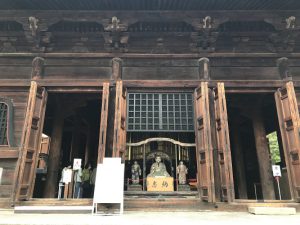
経蔵【きょうぞう】は、宝暦九年(1759)に建立された五間四方宝形【ほうぎょう】造りのお堂です。昭和四十九年(1974)に江戸時代を代表する経蔵建築として重要文化財に指定されています。
内部中央には八角の輪蔵【りんぞう】があり、その中には仏教経典を網羅した鉄眼黄檗版【てつげんおうばくばん】『一切経【いっさいきょう】』全6,771巻が収められています。高さ約17m重さ約5t奥行約15.4mの巨大な輪蔵を時計回りに一周押し回すと、収められた『一切経』を全て読んだことと同じ功徳【くどく】が得られるといわれています。
これも回しましたが、ストップと言われなかったので少し行き過ぎてしましました(笑)
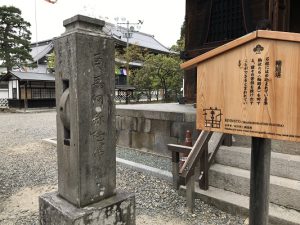
また、経蔵入口には輪蔵を考案した傅大士【ふだいし】の像があります。その他にも、経蔵内には伝教【でんぎょう】・慈覚【じかく】の両大師像などが祀られています。また経蔵の前には南無阿弥陀仏の六字が刻まれた石の輪を回す輪廻塔【りんねとう】があり、その輪を回すことで功徳を積み、極楽往生ができると言われています。
スタッフNもハムスターのごとく回してまいりました。必死になりすぎて指を挟まないよう注意です。
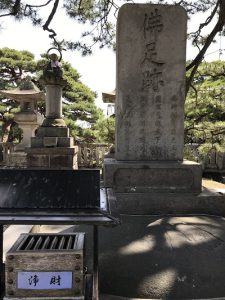
山門の西にある足跡が掘られた石碑は天保九年(1838)に大勧進光純が建立した仏足跡【ぶっそくせき】です。仏足跡は仏像が作られる以前から礼拝の対象であり、古来より仏様がそこに存在した証の一つとして用いられました。仏様の足跡を拝むことは生身の仏様を拝むのと同じく、無量の罪障を滅するといわれます。
仏様には、普通の人間とは異なる姿である「三十二相【さんじゅうにそう】八十種好【はちじっしゅごう】」があると言われていますが、足の裏には「瑞祥七相【ずいしょうしちそう】」という七種の模様や法螺貝などがあります。いつの頃からか健足を願う場となっており、毎年四月に開催される長野マラソンの前後には、多くのランナーが完走を願って手を合わせています。
Nもリングフィットアドベンチャーのやりすぎでランナーではないのにランナー膝になってしまったので、こちらでお願いしてまいりました。

歴代回向柱納所【れきだいえこうばしらおさめじょ】は、山門から第2駐車場へ向かう途中にあります。この納所には複数の大きな木の柱が並んでいます。この柱は回向柱といい、数え年で七年に一度開かれる御開帳のシンボルとして、前立本尊と人々との架け橋となります。回向柱は、御開帳終了後にこの納所へ移され、人々の思いと共に長い年月を経て土に還っていきます。
現在は昭和三十年(1955)から平成二十七年(2015)までの十本の回向柱があり、一番古い柱は高さ約30cm程になっています。
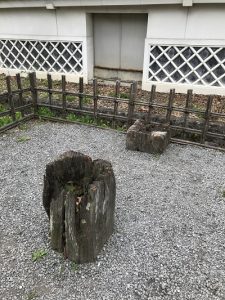
この木を見ていると時の流れと、年月をかけて自然に帰っていく様子を見ることができて、感慨深いものがございますね。
境内地入り口から本堂までの長さ約460m幅約8mに敷かれている石畳【いしだたみ】は、正徳四年(1714)に江戸中橋の大竹屋平兵衛より寄進されたものです。古来より7,777枚あるといわれています。平兵衛は寄進後出家し「道専」と名乗り、そのお墓は善光寺山内の向仏坊の墓地に現存しています。現在この石畳は長野市の文化財に指定されています。
噂によると地元の小学生が実習で数えたところ、6000何枚かしかなかったとか・・・
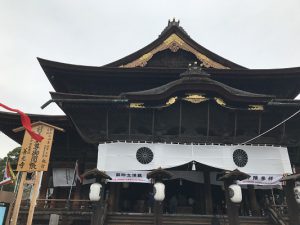
嘉永六年(1853)に再建された鐘楼【しょうろう】は、南無阿弥陀仏の六字にちなみ、六本の柱で建てられています。屋根は大正十五年(1926)に瓦葺から檜皮葺へと変更されております。梵鐘は建物よりも古く、寛永九年(1632)高橋白蓮により発願鋳造されましたが、寛永十九年(1642)の火災により焼失、寛文七年(1667)に再造立された名鐘であり重要美術品に指定されています。毎日午前10時から午後4時の毎正時に時を知らせる鐘として親しまれています。更に長野オリンピックでは開会を告げた鐘として有名になりました。
1月7日には人寄せの鐘として一般の方も叩くことができるそうです。
内仏殿には、近代日本画家を代表する野生司香雪【のうすこうせつ】画伯による善光寺縁起などを描いた壁画をはじめ、雲上殿に入ってすぐのホールには、国際的な活躍を続ける日本画家の千住博画伯の桜図が収められております。
また、雲上殿前にある牛の石像は現在動物供養の場となっており、昭和二十六年(1951)に日印友好の証として送られた聖牛の遺骨も埋葬されています。
そして、善光寺には39の宿坊があり、それぞれに御堂があり、住職がいます。住職は善光寺如来様に奉仕し、その護持に勤めると共に、全国からご参拝の皆さまを仏さまに仕える心でご接待し、お世話をしています。永い伝統を守ってきたそれぞれの宿坊は、凛とした中に、個性のある雰囲気や特徴をもって皆さまをお迎えしています。
また、特徴ある精進料理をはじめ、それぞれに趣向をこらした宿坊料理もお楽しみいただけます。
次回は是非、宿坊に泊まってお朝事参拝したいものです。
写真は禁止で撮れなかったのですが、一番感動したのは内陣の美しさでございました。
古美術好きの皆さまは、感動すること間違いなしです。
ではでは
Hello everyone
This is Staff N.
Today was a happy day when I was able to meet three cats during posting.
However, after that, I got rid of it on my bicycle (laughs).
Please be careful when riding a bicycle.
By the way, I would like to introduce more about Zenkoji Temple in Nagano Prefecture, which I introduced earlier.
The statue of Nio and the three treasures of Aragami and Daikokuten behind the statue of Nio are both made by Koun Takamura and Unkai Yonehara, who are famous as modern sculptors. The statue of Nio is the opposite of the general arrangement. A-un (total height 617.2 cm) is placed on the right and A-un (total height 595.1 cm) is placed on the left.
As a feature of modeling, Koun Takamura incorporates many Western techniques. The prototypes of the 1/4 Nioh statue and the 1/3 Niten statue used in the star-picking method to make a large statue from a small prototype are exhibited at the archives in the Nihon Chureiden. In addition to that, Koun Takamura and Unkai Yonehara are trying to create a new statue of Nioh, which is a Western style that has never been seen in traditional Japanese sculpture, such as the balance between the body and head of the statue and the expression of muscles. It is a statue with the thought of. In addition, the statue of Nio was not colored in order to keep its appearance unchanged even after 100 years. Therefore, the statue of Nio at the time of its construction was white as it was made of wood. The current darkened appearance is due to aging. Recent research has revealed that the statue of Nio is self-sustaining by balancing the center of gravity, which was a great surprise.
This powerful A-un is cool, isn’t it? I feel like I’m being watched everywhere, but I’m sure. Some worshipers enthusiastically took pictures of only their feet.
The Nioumon was erected in the second year of the Horeki (1752), but it was burnt down twice due to the Zenkoji earthquake, etc. It was rebuilt with a 14m frontage of about 13m and a depth of about 7m made of zelkova. At this gate, the amount of “Fixed amount mountain”, which is the mountain number of Zenkoji, is listed. Until the reconstruction, the statue of Nioh, who was familiar as the Nioh of Roza, is currently enshrined in front of Iiyama Station.
Kyozo is a five-storied four-sided treasure-shaped hall built in 1759. In 1974, it was designated as an important cultural property as a Buddhist textbook representing the Edo period.
In the center of the interior is the octagonal ring storehouse [Rinzo], which contains a total of 6,771 volumes of the Tetsugen Oubakuban [All Sutra], which covers the Buddhist scriptures. It is said that if you push a huge ring storehouse with a height of about 17m, a weight of about 5t, and a depth of about 15.4m in a clockwise direction, you will get the same merit as reading all the “All Sutras” contained in it. ..
I also turned this, but I wasn’t told to stop, so I went a little too far (laughs).
Also, at the entrance to the Buddhist textbook, there is a statue of the priest [Fudaishi] who invented the wheel storehouse. In addition, the statues of both ennin and ennin are enshrined in the Keizo. Also, in front of the Keizo, there is a reincarnation tower [Rinnetou] that turns a stone ring engraved with the six characters of Namu Amida Butsu, and it is said that by turning the ring, you can accumulate merit and make a paradise.
Staff N has also turned around like a hamster. Be careful not to get too desperate and pinch your fingers.
The stone monument where the footprints were dug to the west of the mountain gate is the Buddha footprint that was erected by Daikanjin Kojun in 1838. Buddha footprints have been the object of worship even before the Buddha statue was made, and have been used as one of the proofs that the Buddha existed there since ancient times. Worshiping the footsteps of the Buddha is said to extinguish the myriad of sins, just like worshiping a living Buddha.
It is said that the Buddha has “32 phases [sanjuniso] 80 kinds of [Hachijishugo]” which is different from ordinary human beings, but on the soles of his feet. There are seven kinds of patterns and conch shells called “Zuisho Shichiso”. It has been a place to wish for good health for some time, and many runners are joining hands before and after the Nagano Marathon, which is held every April, hoping to finish the race.
N also became a runner’s knee even though he was not a runner due to overdoing Ring Fit Adventure, so I asked for it here.
The successive transfer of merit pillars [Rekidaie Kobashira Osamejo] are on the way from the Sanmon to the second parking lot. This yard is lined with several large wooden pillars. This pillar is called a revolving pillar, and is a symbol of the opening of the book, which is held once every seven years, and serves as a bridge between the main idol and the people. The pillar of merit will be moved to this depot after the opening of the book, and will return to the soil after many years with the thoughts of the people.
Currently, there are ten turning pillars from 1955 (Showa 30) to 2015 (Heisei 27), and the oldest pillar is about 30 cm in height.
Looking at this tree, you can see the passage of time and how it returns to nature over the years, which is very emotional.
The stone pavement [Ishidatami], which is about 460m long and 8m wide from the entrance to the precincts, was donated by Heibei Otakeya of Edo Nakabashi in 1714. It is said that there are 7,777 sheets since ancient times. Heibei left the house after the donation and called himself “Dosen”, and the grave remains in the graveyard of Mukai Buddha in Zenkoji Yamauchi. Currently, this stone pavement is designated as a cultural property of Nagano City.
Rumor has it that local elementary school students counted only 6000 in practice …
The bell tower, which was reconstructed in 1853, is built with six pillars, named after the six characters of Namu Amida Butsu. The roof was changed from a tiled roof to a cypress bark in 1926. The Bonsho is older than the building and was cast by Takahashi Byakuren in 1632, but it was burnt down by a fire in 1642 and rebuilt in 1667. It is designated as an important art object. It is popular as a bell that tells the time every hour from 10 am to 4 pm every day. Furthermore, at the Nagano Olympics, it became famous as the bell that announced the opening.
On January 7th, the general public can also hit it as a crowded bell.
In the inner Buddhist temple, there is a mural painting by Kosetsu Wilderness, a representative of modern Japanese painters, depicting the luck of Zenkoji Temple. Contains the cherry blossoms of the painter Hiroshi Senju.
In addition, the stone statue of the cow in front of the Unjoden is now a place for animal memorial services, and the remains of the holy cow sent as a proof of friendship between Japan and India in 1951 are also buried.
And there are 39 shukubo in Zenkoji, each with a temple and a priest. The chief priest serves and protects Zenkoji Nyorai, and at the same time, he treats and takes care of worshipers from all over the country with the heart of serving the Buddha. Each shukubo, which has maintained a long tradition, welcomes you with its unique atmosphere and characteristics while being dignified.
In addition, you can enjoy the unique vegetarian cuisine as well as the shukubo cuisine with each taste.
Next time, I definitely want to stay at the shukubo and worship in the morning.
I couldn’t take a picture because it was prohibited, but what impressed me most was the beauty of the Chancel.
If you like antique art, you will surely be impressed.
See you soon
*********************
もうすぐGWでございますね。
風光舎では、古美術品や骨董品の他にも絵画や宝石、趣味のお品など様々なジャンルのものを買受しております。
お片付けをされていて、こういうものでもいいのかしらと迷われているものでも、どうぞお気軽にご相談下さいませ。
また風光舎は、出張買取も強化しております。
ご近所はもちろん、愛知県内、岐阜県、三重県その他の県へも出張いたします。
まずは、お電話お待ちしております。
愛知県名古屋市千種区・骨董 買取
『古美術 風光舎 名古屋店』
TEL 052(734)8444
10:00-17:00 OPEN

